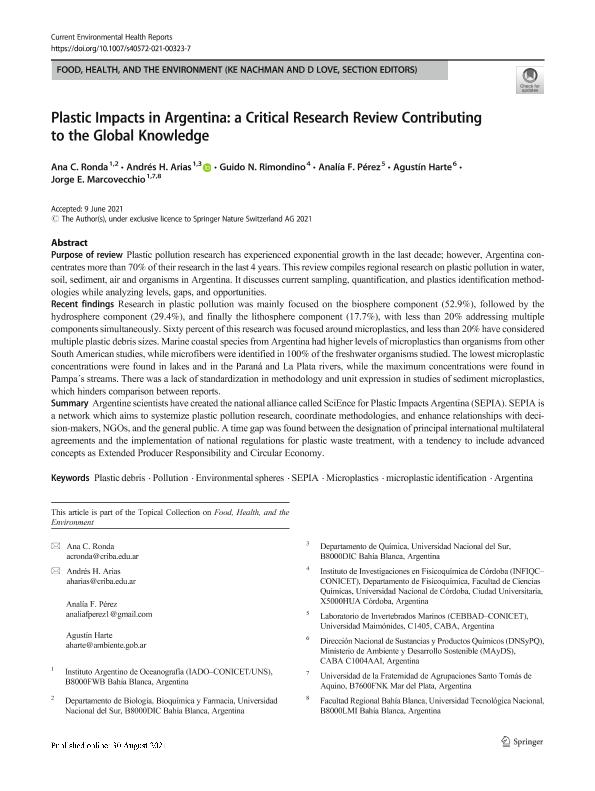Mostrar el registro sencillo del ítem
dc.contributor.author
Ronda, Ana Carolina

dc.contributor.author
Arias, Andres Hugo

dc.contributor.author
Rimondino, Guido Noé

dc.contributor.author
Pérez, Soledad Analía

dc.contributor.author
Harte, Agustín
dc.contributor.author
Marcovecchio, Jorge Eduardo

dc.date.available
2023-10-17T14:04:31Z
dc.date.issued
2021-09
dc.identifier.citation
Ronda, Ana Carolina; Arias, Andres Hugo; Rimondino, Guido Noé; Pérez, Soledad Analía; Harte, Agustín; et al.; Plastic Impacts in Argentina: a Critical Research Review Contributing to the Global Knowledge; Springer; Current Environmental Health Reports; 8; 3; 9-2021; 212-222
dc.identifier.issn
2196-5412
dc.identifier.uri
http://hdl.handle.net/11336/215176
dc.description.abstract
Purpose of review: Plastic pollution research has experienced exponential growth in the last decade; however, Argentina concentrates more than 70% of their research in the last 4 years. This review compiles regional research on plastic pollution in water, soil, sediment, air and organisms in Argentina. It discusses current sampling, quantification, and plastics identification methodologies while analyzing levels, gaps, and opportunities. Recent findings: Research in plastic pollution was mainly focused on the biosphere component (52.9%), followed by the hydrosphere component (29.4%), and finally the lithosphere component (17.7%), with less than 20% addressing multiple components simultaneously. Sixty percent of this research was focused around microplastics, and less than 20% have considered multiple plastic debris sizes. Marine coastal species from Argentina had higher levels of microplastics than organisms from other South American studies, while microfibers were identified in 100% of the freshwater organisms studied. The lowest microplastic concentrations were found in lakes and in the Paraná and La Plata rivers, while the maximum concentrations were found in Pampa´s streams. There was a lack of standardization in methodology and unit expression in studies of sediment microplastics, which hinders comparison between reports. Summary: Argentine scientists have created the national alliance called SciEnce for Plastic Impacts Argentina (SEPIA). SEPIA is a network which aims to systemize plastic pollution research, coordinate methodologies, and enhance relationships with decision-makers, NGOs, and the general public. A time gap was found between the designation of principal international multilateral agreements and the implementation of national regulations for plastic waste treatment, with a tendency to include advanced concepts as Extended Producer Responsibility and Circular Economy.
dc.format
application/pdf
dc.language.iso
eng
dc.publisher
Springer

dc.rights
info:eu-repo/semantics/openAccess
dc.rights.uri
https://creativecommons.org/licenses/by-nc-sa/2.5/ar/
dc.subject
ARGENTINA
dc.subject
ENVIRONMENTAL SPHERES
dc.subject
MICROPLASTIC IDENTIFICATION
dc.subject
MICROPLASTICS
dc.subject
PLASTIC DEBRIS
dc.subject
POLLUTION
dc.subject
SEPIA
dc.subject.classification
Oceanografía, Hidrología, Recursos Hídricos

dc.subject.classification
Ciencias de la Tierra y relacionadas con el Medio Ambiente

dc.subject.classification
CIENCIAS NATURALES Y EXACTAS

dc.title
Plastic Impacts in Argentina: a Critical Research Review Contributing to the Global Knowledge
dc.type
info:eu-repo/semantics/article
dc.type
info:ar-repo/semantics/artículo
dc.type
info:eu-repo/semantics/publishedVersion
dc.date.updated
2023-10-17T09:52:08Z
dc.journal.volume
8
dc.journal.number
3
dc.journal.pagination
212-222
dc.journal.pais
Reino Unido

dc.journal.ciudad
Londres
dc.description.fil
Fil: Ronda, Ana Carolina. Consejo Nacional de Investigaciones Científicas y Técnicas. Centro Científico Tecnológico Conicet - Bahía Blanca. Instituto Argentino de Oceanografía. Universidad Nacional del Sur. Instituto Argentino de Oceanografía; Argentina
dc.description.fil
Fil: Arias, Andres Hugo. Consejo Nacional de Investigaciones Científicas y Técnicas. Centro Científico Tecnológico Conicet - Bahía Blanca. Instituto Argentino de Oceanografía. Universidad Nacional del Sur. Instituto Argentino de Oceanografía; Argentina
dc.description.fil
Fil: Rimondino, Guido Noé. Consejo Nacional de Investigaciones Científicas y Técnicas. Centro Científico Tecnológico Conicet - Córdoba. Instituto de Investigaciones en Físico-química de Córdoba. Universidad Nacional de Córdoba. Facultad de Ciencias Químicas. Instituto de Investigaciones en Físico-química de Córdoba; Argentina
dc.description.fil
Fil: Pérez, Soledad Analía. Consejo Nacional de Investigaciones Científicas y Técnicas; Argentina. Universidad Maimónides. Área de Investigaciones Biomédicas y Biotecnológicas. Centro de Estudios Biomédicos, Biotecnológicos, Ambientales y de Diagnóstico; Argentina
dc.description.fil
Fil: Harte, Agustín. Ministerio de Ambiente y Desarrollo Sustentable. Secretaria de Control y Monitoreo Ambiental. Direccion Nacional de Sustancias y Productos Quimicos.; Argentina
dc.description.fil
Fil: Marcovecchio, Jorge Eduardo. Consejo Nacional de Investigaciones Científicas y Técnicas. Centro Científico Tecnológico Conicet - Córdoba. Instituto de Investigaciones en Físico-química de Córdoba. Universidad Nacional de Córdoba. Facultad de Ciencias Químicas. Instituto de Investigaciones en Físico-química de Córdoba; Argentina. Universidad Tecnológica Nacional; Argentina
dc.journal.title
Current Environmental Health Reports
dc.relation.alternativeid
info:eu-repo/semantics/altIdentifier/url/https://link.springer.com/10.1007/s40572-021-00323-7
dc.relation.alternativeid
info:eu-repo/semantics/altIdentifier/doi/http://dx.doi.org/10.1007/s40572-021-00323-7
Archivos asociados
